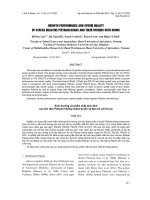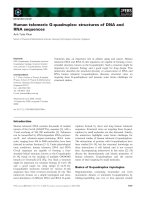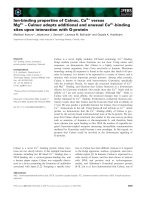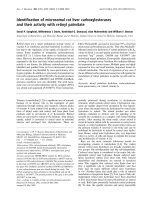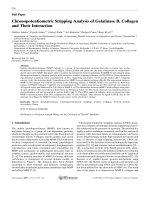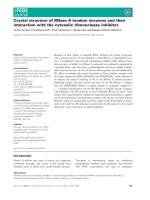Synthesis and structure investigation of stabilized aromatic oligoamides and their interaction with g quadruplex structures 3
Bạn đang xem bản rút gọn của tài liệu. Xem và tải ngay bản đầy đủ của tài liệu tại đây (767.41 KB, 21 trang )
89
Chapter 3
Helical Organization in Foldable Aromatic Oligoamides
3.1 Introduction
Largely driven by a strong desire to build biopolymer-like functions into much
simpler yet completely abiotic systems, there have been many recent advances in
elegantly devised folding systems geared toward designing unnatural folding
helices.(for recent reviews)
1
. In particular, the helical organization emanating from
multiply centered hydrogen bonds (H-bonds) has attracted special interest in recent
years.
1a-j
Despite substantial exceptions
2
, the exact helical dimensions and
properties for a large portion of the hitherto known molecular helices have always
remained as eminently intriguing in the absence of crystal structures.
1j,3
Obtaining
such quantitative descriptions of molecular properties in solid state is critically
important as this very often leads to insightful, testable hypotheses,
2i
and novel
utilities in such as functional foldamer design
1j, 1l,4
as well as reveals gaps in our
current understanding that must be filled.
90
3.2 Result and Discussion
3.2.1 Helical Conformation in Pentamer 5 and Hexamer 6
1
5
6
10
11
15
16
20
21
25
N
H
O
O
N
N
O
H
O
O O
O
H
O
O
N
H
O
O
2
N
O
R
1
R
2
R
3
R
4
N
H
O
O
N
N
O
H
O
O O
O
H
O
O
O
2
N
3
R
2
R
1
5
6
5b: R
1
=O(CH
2
)
7
CH
3
,R
2
=R
4
=OCH(CH
3
)
2
,R
3
=CH
3
5a: R
1
=R
2
=R
3
=R
4
=H
6b: R
1
=O(CH
2
)
7
CH
3
,R
2
=OCH(CH
3
)
2
6a: R
1
=R
2
=H
2
3
4
7
13
12
8
9
14
17
19
24
22
18
23
5c: R
1
=O(CH
2
)
7
CH
3
,R
2
=OCH(CH
3
)
2
,R
3
=R
4
=CH
3
6c: R
1
=CH
3
,R
2
=OCH(CH
3
)
2
Early investigations
3c,5
have established a crescent folding backbone in solid state
for internally H-bonded oligomers of up to trimer with repeating units represented by
oligomers 5 and 6. Although the corresponding helical conformation for longer
oligomers in solution has not been investigated, early molecular modeling
5a
on a
hexamer like 6a using the MM3 force field suggested it to adopt a crescent,
two-dimensional conformation that encloses an acyclic, open-ended cavity of ~ 4.3
in radius defined by six interior methoxy oxygen atoms (or 2.9 after deducting a
covalent radius of 1.4 for oxygen atom); on this basis, a hexameric, head to tail
binding mode was proposed to account for the helicity induction in
porphyrin-modified hexamer by six chiral C
60
-incorporating histidines.
3c
The
existence of such a large cavity of 2.9 , however, may seem uncertain as amide
linkages are known to possess a great degree of plasticity in bond angles, instructing
91
the H-bond rigidified backbone to curve toward the H-bonded side.
1f,2c
Our
computational molecular modeling at the level of B3LYP/6-31G* on 5a showed that
oligomers of higher than tetramer should take up a helical backbone rather than the
planar conformation as proposed previously.
3c,5a
Consequently, a helical cavity of
~1.4 in radius that is much smaller than 2.9 should result. Consistent with these
modeling results, we now provide here the solid state evidences involving helical
organizations in 5a and 6a by a continuous H-bonding network and the convincing
2D NOESY studies that support the helically folded conformations adopted by 5b and
6b and 6c, respectively, in solution. These distinct helically folded conformations may
better explain the helicity induction observed previously.
3c
Figure 3.1. Side and top views of oligoamides 5 and 6: (a) crystal structure of pentamer 5a, (b) ab initio
calculated structure of 5a and (c) crystal structure of hexamer 6a. Interior methoxy methyl groups are
omitted for clarity.
As mentioned in chapter 2, Oligomers 5 and 6 were synthesized from
commercially available salicylic acid and 2,5-dihydroxybenzoic acid in 12-18 steps.
Crystals of 5a and 6a suitable for X-ray structure determination were obtained by
slow evaporation of 5a and 6a in mixed solvents containing hexane and chloroform
92
(1:1 v/v) for 5a and hexane and dichloromethane (1:1 v/v) for 6a at room temperature.
Their crystal structures viewed along or perpendicular to helical axis are presented in
Fig. 3.1a and 3.1c. The common structural features shared between 5a and 6a are the
following: (1) both unit cells contain two enantiomeric helices of opposite helical
senses (e.g., right/left handed) that tightly stack on each other with no inclusion of
solvent molecules; (2) both structures possess a helical periodicity of ~five repeating
units per turn; (3) the interior methoxy groups, pointing up and down alternatively, fill
the helix hollow of ~1.4 in radius and completely prevent them from the
encapsulation of guest molecules; and (4) as expected, all the inward-pointing amide
protons and methoxy oxygen atoms participate in the formation of a continuous
internally located H-bonding network that comprises up to ten intramolecular
H-bonds (NH
…
OMe = 1.933-2.306 Å). One disparity between 5a and 6a involves the
helical pitch. While hexamer 6a has a pitch of ~ 3.4 Å typically observed in aromatic
foldamers,
2a-f
an appreciably larger helical pitch of 5 Å is observed in 5a. Such a large
pitch may stem, in part, from the steric crowdedness involving the two end methoxy
groups in the absence of favorable π-π stacking interactions and was also found in an
aliphatic peptoid foldamer in solid state.
2g
The solid state structures of 5a and 6a (1)
provide the most conclusive evidence for the adoption of a helical conformation by
the foldable molecular strands 5a and 6a, (2) validate our conceptual reasoning and
others’ observations
1f,2c
detailing a significant effect the H-bonding forces may have
on the backbone curvature of aromatic folamers and (3) corroborate the power of ab
93
initio molecular modeling at the B3LYP/6-31G* level in the satisfactory prediction of
3D topologies of aromatic foldamers.
2f,6
.
Figure 3.2.
1
H NMR spectra of pentamers. (a) pentamer 5a (500 MHz, 5 mM, 298 K, CDCl
3
) and (b)
pentamer 5b (800 MHz, 25 mM, 298 K, CDCl
3
).
The highly repetitive nature of 5a (Figure 3.2a) and 6a
6
led to the extensive
1
H
NMR signal overlaps among aromatic protons, hampering the elucidation of their
folded structures in solution. To overcome this difficulty, linear and branched alkoxyl
side chains as well as a methyl group para to the interior methoxy groups are
deliberately introduced into 5b. At 25 mM, the
1
H NMR spectrum of 5b recorded in
CDCl
3
displays highly dispersed proton resonances for most of its protons (Figure
3.2b). The amide protons resonating at low fields (9.87-10.36 ppm) are in line with
the existence of strong intramolecular H-bonds in 5b.
2c,2d
Since the inter-atomic
distances between amide and methoxy protons from the crystal structure of 5a range
from 2.279 to 3.690 Å, two NOE contacts between every amide proton and its adjacent
methoxy methyl groups should be seen in the 2D NOESY spectrum if a folded
conformation does prevail for 5b in solution. The well-resolved amide protons and
internal methoxy groups of 5b indeed permit us to observe the expected eight NOE
94
cross peaks, two for each amide protons. Presumably owing to its unusually large
helical pitch (5 Å), the NOEs between the end residues that are indicative of the helical
conformation of 5b was not detected (Figure 3.3).
Figure 3.3. NOE contacts (NOESY, 800 MHz, 25 mM, 298 K, 500 ms, CDCl
3
) seen between amide
protons and their adjacent interior methoxy protons of 5b.
Figure 3.4 demonstrated full spectrum of NOESY and partial spectrum of TOCSY.
The TOCSY sequence is a homonuclear experiment which produces a COSY-like plot.
COSY gives correlations between protons that are coupled to one another, while
TOCSY gives correlations between all protons in a given spin system. In our
experiment, TOCSY turns out to be the most efficient method to determine aromatic
protons that are adjacent to each other. The contacts between amide protons and
aromatic protons could also be observed easily by TOCSY (Figure 3.4c).
95
a)
b) c)
Figure 3.4. 2D NOESY (25 mM, 800 MHz, 298 K, 500 ms) & TOCSY (80ms) studies of pentamer 5b
in CDCl
3
. (a) Full spectrum (2D NOESY), (b) Partial spectrum (2D NOESY) showing contacts
observed between external side chain protons and aromatic protons), (c) Partial spectrum (2D TOCSY)
showing contacts observed between amide protons and aromatic protons.
Such a helical conformation, however, can be confirmed by 2D NOESY study for
longer oligomers such as 6 where the favorable π-π stacking interactions between the
first and sixth aromatic rings bring the two end residues closer to each other, leading
to a typically observed helical pitch of ~ 3.4 Å for aromatic foldamers.
96
Correspondingly, a strong NOE cross peak between the end ester methyl protons 1
and the aromatic proton 24, serving as an indicator for helical formation, was
observed for 6c at 10 mM in CDCl
3
. The existence of this helical conformation can be
nicely supported by the ab initio molecular modeling at the level of B3LYP/6-31G*
and the determined crystal structure of 6a (Figure 3.1c), both of which point to an
energetically optimized configuration for 6c where the six interior methoxy methyl
groups point up and down alternatively along the aromatic backbone helically biased
by a continuous H-bonding network.
Before pentamer 5b and hexamer 6b were designed, pentamer 5c and hexamer 6c
modified with various side chains were actually made first to probe the helical
conformation that may be adopted by these longer oligomers. However, the side
chains introduced into 5c do not give rise to a complete resolution of amide protons
and internal methoxy methyl groups. As to 6c, although good end-to-end NOE
contacts between either proton 1 or proton 5 and aromatic proton 24 can be detected
in CDCl
3
at 283 K but not 298K, the signal overlap between protons 1 and 5 makes
the accurate assignment of
1
H NMR signals difficult. This issue can be solved by
addition of up to 25% DMSO-d
6
into CDCl
3
, leading to a good separation between
protons 1 and 5 in both 6b and 6c (Figure 3.6). However, 2D NOESY collected for 4
hrs at 10 mM in 3:1 CDCl
3
/DMSO-d
6
at either 283 K or 298 K failed to yield
detectable NOE contact between protons 1 and 24 in 6c. Consequently, either crescent
or helical conformation concerning oligomers 5c and 6c can not be confidently
deduced.
97
6c
24
15
24
1,5
24
1
5
1
5
24
24
1
24
1
5
e) f)
a) b) c) d)
Figure 3.5. 2D NOESY (500 MHz, 10 mM, 500 ms) & ROESY (500 MHz 10 mM, 200 ms) studies of
6c, showing end-to-end contact between protons 1 and 24 that is indicative of helical conformation. (a)
2D NOESY (283 K, CDCl
3
, 4 hrs), (b) 2D NOESY (298 K, CDCl
3
, 4 hrs), (c) 2D NOESY (283 K,
CDCl
3
/DMSO-d
6
(3:1 v/v), 4 hrs), (d) 2D NOESY (283 K, CDCl
3
/DMSO-d
6
(3:1 v/v), 8 hrs), (e) 2D
NOESY (298 K, CDCl
3
/DMSO-d
6
(3:1 v/v), 8 hrs) and (f) 2D ROESY (298 K, CDCl
3
/DMSO-d
6
(3:1
v/v), 4 hrs). Compared to (d), NOE peak intensity in (e) is much weaker.
98
25%
20%
15%
10%
5%
51
25%
20%
15%
10%
5%
51
25%
20%
15%
10%
5%
25%
20%
15%
10%
5%
a)
b)
Figure 3.6. Effect of DMSO-d
6
percentage in CDCl
3
on the
1
H NMR signal dispersion involving
protons 1 and 5 in hexamers: (a) hexamer 6b and (b) hexamer 6c.
Before it was realized that lengthening the total acquisition time of 2D NOESY
from 4 hrs to about 8 hrs in 3:1 CDCl
3
/DMSO-d
6
allows us to detect an end-to-end
contact between proton 1 and proton 24 in 6c (Figures 3.5d and 3.5e), we decided to
replace the methyl side chain at the nitro end with an isopropyloxy side chain to
generate 5b and with an octyloxy side chain to generate 6b. Such a minute difference
in structure pleasingly leads to completely resolved
1
H NMR signals for critically
important protons that allow us to unambiguously confirm a crescent conformation
99
for 5b in pure CDCl
3
and a helical structure for 6b in 3:1 CDCl
3
/DMSO-d
6
at room
temperature. 6c was also confirmed to assume a helical conformation in solution by
2D NOESY experiment with a longer acquisition time (Figures 3.5d and 3.5e) or by
2D ROESY study (Figure 3.5f).
As mentioned above, the incorporation of two different side chains into 6b at only
one end differentiates the aromatic proton signals of the modified end units from all
the other remaining units in the same molecule in CDCl
3
. Addition of 25% DMSO-d
6
into CDCl
3
further separates ester methyl protons 1 from the interior methoxy methyl
protons 5. As such, the ROE cross peak between the end units (methyl protons 1 and
aromatic proton 24, Figure 3.7) is clearly identifiable. This end-to-end ROE, along
with the observation of numerous ROE contacts among amide protons and their
adjacent interior methoxy protons, evidently support the presence of the H-bond
enforced helical ordering in 6b in solution that leads to the stacking of one end over
the other. Observation of these end-to-end NOE or ROE contacts in 6b (Figure 3.7)
fully accords with the shortest inter-atomic distance (2.748 Å) found between protons
1 and 24 in the crystal structure of 6a.
100
O
O
O
O
O
O
O
O
O
O
O
O
O
NO
2
N
HN
HN
N
H
NH
CH
3
H
OR
2
R
1
O
H
Me
24
1
5
6b
Figure 3.7. End-to-end NOE (top, 500 MHz, 20 mM, 283 K, 500 ms, CDCl
3
) and ROE (bottom,
ROESY, 500 MHz, 15 mM, 298 K, 200 ms, CDCl
3
/25%DMSO-d
6
) contacts seen between the end
units of 6b.
a) b)
(24,1)
(24,1)
101
c) d )
e) f )
Figure 3.8. 2D NOESY (500 MHz, 20 mM, 283 K, CDCl
3
, 500 ms) and ROESY (500 MHz, 15 mM,
298 K, CDCl
3
/DMSO-d
6
(3:1 v/v), 200 ms) studies of hexamer 6b. (a) Full spectrum (2D NOESY)
showing end-to-end contacts, (b) Full spectrum (2D ROESY) showing end-to-end contacts, (c) Partial
spectrum (2D NOESY) showing contacts observed between aromatic protons and their adjacent
alkoxyl protons, (d) Partial spectrum (2D ROESY) showing contacts observed between aromatic
protons and their adjacent alkoxyl protons, (e) Partial spectrum (2D NOESY) showing contact
observed between amide protons and their adjacent interior methoxy protons, (f) Chemical structure of
6b.
More NOESY, ROESY and TOXSY studies of 6b were demonstrated in Figure 3.8
and Figure 3.9. Figure 3.8c and 3.8d show the contacts between aromatic protons and
their adjacent alkoxyl protons, observed by NOESY and ROESY, respectively.
N
H
O
O
N
N
O
H
O
O O
O
H
O
O
N
H
O
N
OH
O
O
O
2
N
1
2
3
4
5
6
7
O
O
CH
2
(CH
2
)
6
CH
3
8
9
10
11
12
13
14
15
16
17
18
19
20
21
22
23
24
25
26
27
28
29
6b
102
Contacts between amide protons and their adjacent interior methoxy protons in 6b
were shown in Figure 3.7e. The well-resolved amide protons and internal methoxy
groups of 6b permit us to observe the expected ten NOE cross peaks, two for each
amide protons.
Figure 3.9. 2D TOCXY (500 MHz, 20 mM, 298 K, CDCl
3
, mixing time: 80 ms) study of hexamer 6b.
(a) Full spectrum, (b) Partial spectrum showing contact observed between aromatic protons and
aromatic protons.
3.2.2 Helical Conformation of Heptamer 7
Scheme 3.1. Synthesis of heptamer 7
a
N
H
O
O
NO
2
N
O
H
O
O
OH
O
3
g
O
OC
8
H
17
N
H
O
O
O
O
O
NO
O
N
H
H
O
O
NO
2
4a
a, b
N
H
O
O
N
N
O
H
O
O O
O
H
O
O
N
H
O
O
2
N
O O
OC
8
H
17
7
3
+
a
a) 3g, (COCl)
2
, DMF, CH
2
Cl
2
; b) H
2
, Pd/C, THF, 40
o
C, 4a, then TEA/CH
2
Cl
2
.
Heptamer 7 was obatained by a convergent route with relatively high yield 15%.
For high-level oligomers, convergent coupling was used more frequently than
a) b)
103
stepwise fashion in order to saving time. However, the reaction yield was usually low
due to the steric hindrance imposed by helical conformation of oligoamides.
Figure 3.10.
1
H NMR spectra of heptamer 7 (500 MHz, 5 mM, 298 K, CDCl
3
).
One dimensional 1H NMR of heptamer 7 was presented in Figure 3.10. Similar to
pentamer and hexamer, the amide protons resonate at low fields (9.71-10.15 ppm),
suggesting the existence of strong intramolecular H-bonds in 7. Furthermore, the
crescent and helical structure in 7 was probed by 2D NOESY study (Figure 3.11).
NOE contacts between amide proton and its adjacent methoxy methyl groups could be
observed in the 2D NOESY spectrum, suggesting a folded conformation of 7 in
solution. However, the aromatic protons in 7 were too overlapping, making it hard to
assign them. Accordingly, amide protons and methoxy methyl group could not be
determined. The only aromatic protons (27, 29, 32, 34) that could be assigned are the
ones at the last two benzyl units adjacent to nitro group end, due to their interaction
with exterior side chains (Figure 3.11c). Although the position of each aromatic
proton is unclear, a strong NOE cross between methyl proton and aromatic proton was
observed, which is similar to end-to-end contact in 6b and 6c. Obviously, the aromatic
proton was not belongs to monomeric units at the nitro end (27, 29, 32, 34). Thus, it
was assumed be the NOE between the end ester methyl protons 1 and the aromatic
104
proton 24.
a)
b) c)
Figure 3.11. 2D NOESY (500 MHz, 20 mM, 298 K, CDCl
3
, 500 ms) study of heptamer 7. (a) Full
spectrum, (b) Partial spectrum showing contact observed between amide protons and their adjacent
interior methoxy protons, (c) Partial spectrum showing contact observed between aromatic protons and
their adjacent
interior methoxy protons.
To validate this assumption, single crystal was tried to be grown by our traditional
slow evaporation method. Unfortunately, solid state structure of heptamer 7 could not
be obtained despite of various solvent pairs. To predict the structure of 7, ab initio
molecular modeling was performed. As seen in Figure 3.12, heptamer 7 possess a
1
5
6
25
26
30
31
35
N
H
O
O
N
N
O
H
O
O O
O
H
O
O
N
H
O
O
2
N
O O
OC
8
H
17
7
2
3
4
23
24
27
29
34
32
28
33
22
3
105
helical periodicity of about five repeating units per turn and has a typical pitch of ~
3.4 Å. All these results were in agreement with previous studies of pentamer and
hexamer. Hereto, the similarity of helical conformation in hexamer and heptamer
again prove the structural predictability of those designed oligoamides. Moreover, the
close distance between ester methyl group 1 and aromatic proton 24 corresponds well
with the end-to-end NOE contact found in 2D NOESY spectrum (Figure 3.12b).
a) b) c)
Figure 3.12. Ab initio calculated structure of heptamer 7. (a) top views, (b) side views, (c) side views.
3.3 Conclusion
To summarize, the helical propagation over several internally rigidified, lengthened
oligoaromatic backbones as in 5, 6 and 7 in solution and solid states has been
established experimentally and substantiated theoretically by the computational
molecular modeling at the B3LYP/6-31G* level. The detailed elucidation of such
structural information contained within the helically folded framework should guide
the design of supramolecular (bio)nanoarchitectures of increasing complexity via
106
peripheral functionalizations, which may find important utilities in a variety of
materials science,
3c
medicinal
1l, 4
and biological settings.
1l, 4a-c
.
3.4 Experimental Section
Compound 7:
Compound 4a (0.20 g, 0.32 mmol) was reduced by catalytic hydrogenation in THF
(15 mL) at 50
o
C, using Pd-C (0.040 g, 20%) as the catalyst for 3 h. The reaction
mixture was then filtered and the solvent removed in vacuo to give the pure amine
which was immediately used for the next coupling. Acid 3g (0.38 g, 0.5 mmol) was
placed in a very dry round bottom flask and saturated with nitrogen gas.
Freshly-prepared dry CH
2
Cl
2
(5 mL) and DMF (27 μL) were added to the acid,
followed by dropwise addition of oxalyl chloride (67 μL, 0.53 mmol). The reaction
mixture was allowed to stir for 4 hrs. The solvent was then removed in vacuo and
saturated with nitrogen gas before addition of 10 mL dry CH
2
Cl
2
. The above amine
(0.17 g, 0.36 mmol) was dissolved in 10 mL dry CH
2
Cl
2
and triethylamine (0.10 mL,
0.69 mmol) before addition to the reaction mixture above. The reaction mixture was
stirred at 50
o
C for 6 hrs and then was washed with aq NaHCO
3
(50 mL). Drying over
anhydrous Na
2
SO
4
and removal of solvent in vacuo gave the crude product which was
recrystallised from methanol and further purified by flash column chromatography
(silica gel as the stationary phase) using Hexane/EA (2:1 v/v) as the eluent to give
pure product 7 as a white solid. Yield: 50 mg, 15%.
1
H NMR (500 MHz, CDCl
3
) δ
10.15 (s, H), 10.12 (s, 1H), 10.07 (s, 1H), 10.00 (s, 1H), 9.81 (s, 1H), 9.71 (s, 1H),
107
8.78 (m, 5H), 8.34 (d, 1H, J = 3.2), 7.91 (d, 1H, J = 6.7), 7.86 (m, 3H), 7.81 (d, 1H, J
= 6.8), 7.40 (d, 1H, J = 3.2), 7.37 (m, 5H), 7.31 (t, 1H), 7.17 (t, 1H), 4.63 (m, 1H),
4.05 (s, 3H), 4.04 (s, 3H), 4.02 (s, 2H), 4.00 (s, 3H), 3.94 (s, 3H), 3.90 (s, 6H), 3.83 (s,
3H), 3.82 (s, 3H), 1.67 (m, 2H), 1.48 (s, 6H), 1.27 (m, 8H), 1.15 (m, 2H), 0.66 (m,
3H).
13
C NMR (125 MHz, CDCl
3
) δ 165.43, 163.43, 163.01, 162.81, 162.67, 161.13,
155.38, 155.08, 149.09, 147.43, 147.39, 147.19, 147.09, 144.42, 143.95, 140.53,
132.91, 132.53, 132.36, 132.28, 132.21, 132.13, 129.39, 126.91, 126.83, 126.69,
126.52, 126.45, 125.63, 125.45, 125.36, 124.94, 124.80, 124.63, 124.42, 123.11,
121.23, 115.01, 112.60, 112.49, 70.68, 69.29, 67.05, 64.49, 63.31, 63.10, 63.00, 62.97,
62.91, 62.32, 53.23, 31.74, 29.66, 29.21, 29.16, 28.90, 25.86, 22.61, 21.96, 14.07.
HRMS-ESI: calculated for [M+Na]
+
(C
41
H
37
N
3
O
13
Na): m/z 1314.4881 found: m/z
1314.4877.
108
Reference:
1. (a) Gellman, S. H., Acc. Chem. Res. 1998, 31, 173. (b) Gong, B., Chem. Eur. J. 2001, 7, 4336. (c)
Hill, D. J.; Mio, M. J.; Prince, R. B.; Hughes, T. S.; Moore, J. S., Chem. Rev. 2001, 101, 3893. (d)
Sanford, A. R.; Gong, B., Curr. Org. Chem. 2003, 7, 1649. (e) Schmuck, C., Angew. Chem. Int. Ed.
2003, 42, 2448. (f) Huc, I., Eur. J. Org. Chem. 2004, 17. (g) Sanford, A. R.; Yamato, K.; Yang, X.;
Yuan, L.; Han, Y.; Gong, B., Eur. J. Biochem. 2004, 271, 1416. (h) Cheng, R. P., Curr. Opin.
Struc. Biol. 2004, 14, 512. (i) Licini, G.; Prins, L. J.; Scrimin, P., Eur. J. Org. Chem. 2005, 969. (j)
Goodman, C. M.; Choi, S.; Shandler, S.; DeGrado, W. F., Nat. Chem. Biol. 2007, 3, 252 (k)
Albrecht, M., Chem. Rev. 2001, 101, 3457. (l) Cheng, R. P.; Gellman, S. H.; DeGrado, W. F.,
Chem. Rev. 2001, 101, 3219.
2. (a) Hamuro, Y.; Geib, S. J.; Hamilton, A. D., J. Am. Chem. Soc. 1997, 119, 10587. (b) Berl, V.;
Huc, I.; Khoury, R. G.; Krische, M. J.; Lehn, J. M., Nature 2000, 407, 720. (c) Gong, B.; Zeng, H.;
Zhu, J.; Yuan, L.; Han, Y.; Cheng, S., Proc. Natl. Acad. Sci. USA 2002, 99, 11583. (d) Jiang, H.;
Léger, J M.; Huc, I., J. Am. Chem. Soc. 2003, 125, 3448. (e).Garric, J.; Huc, J M. L. I., Angew.
Chem. Int. Ed. 2005, 44, 1954. (f) Tie, C.; Gallucci, J. C.; Parquette, J. R., J. Am. Chem. Soc. 2006,
128, 1162. (g) Wu, C. W.; Kirshenbaum, K.; Sanborn, T. J.; Patch, J. A.; Huang, K.; Dill, K. A.;
Zuckermann, R. N.; Barron, A. E.,
J. Am. Chem. Soc. 2003, 125, 13525. (h) Yang, D.; Zhang,
Y H.; Li, B.; Zhang, D W.; Chan, J. C Y.; Zhu, N Y.; Luo, S W.; Wu, Y D., J. Am. Chem. Soc.
2004, 126, 6956. (i) Choi, S. H.; Guzei, I. A.; Gellman, S. H., J. Am. Chem. Soc. 2007, 129, 13780.
(j) Schmitt, M. A.; Choi, S. H.; Guzei, I. A.; Gellman, S. H., J. Am. Chem. Soc. 2006, 128, 4538.
(k) Horne, W. S.; Price, J. L.; Keck, J. L.; Gellman, S. H., J. Am. Chem. Soc. 2007, 129, 4178. (l)
Gan, Q.; Bao, C. Y.; Kauffmann, B.; Grelard, A.; Xiang, J. F.; Liu, S. H.; Huc, I.; Jiang, H., Angew.
Chem. Int. Ed. 2008, 47, 1715.
3. (a) Li, C.; Ren, S F.; Hou, J L.; Yi, H P.; Zhu, S Z.; Jiang, X K.; Li, Z T., Angew. Chem. Int.
Ed. 2005, 44, 5725. (b)Sinkeldam, R. W.; Hoeben, F. J. M.; Pouderoijen, M. J.; DeCat, I.; Zhang,
J.; Furukawa, S.; DeFeyter, S.; Vekemans, J. A. J. M.; Meijer, E. W., J. Am. Chem. Soc. 2006, 128,
16113. (c) Hou, J L.; Yi, H P.; Shao, X B.; Li, C.; Wu, Z Q.; Jiang, X K.; Wu, L Z.; Tung,
C H.; Li, Z T., Angew. Chem. Int. Ed. 2006, 45, 796. (d) Nelson, J. C.; Saven, J. G.; Moore, J. S.;
Wolynes, P. G., Science 1997, 277, 1793. (e) Cuccia, L. A.; Lehn, J M.; Homo, J C.; Schmutz,
M., Angew. Chem. Int. Ed. 2000, 39, 233. (f) Dolain, C.; Maurizot, V.; Huc, I., Angew. Chem. Int.
Ed. 2003, 42, 2738. (g) Yang, X. W.; Brown, A. L.; Furukawa, M.; Li, S.; Gardinier, W. E.;
Bukowski, E. J.; Bright, F. V.; Zheng, C.; Zeng, X. C.; Gong, B., Chem. Commun. 2003, 56. (h)
Gorp, J. J. v.; Vekemans, J. A. J. M.; Meijer, E. W., Chem. Commun. 2004, 60. (i) Hou, J. L.; Shao,
X. B.; Chen, G. J.; Zhou, Y. X.; Jiang, X. K.; Li, Z. T., J. Am. Chem. Soc. 2004, 126, 12386. (j)
Abe, H.; Masuda, N.; Waki, M.; Inouye, M., J. Am. Chem. Soc. 2005, 127, 16189. (k) Khan, A.;
Kaiser, C.; Hecht, S., Angew. Chem. Int. Ed. 2006, 45, 1878. (l) Zhao, Y.; Zhong, Z. Q.; Ryu, E. H.,
J. Am. Chem. Soc. 2007, 129, 218.
4. (a) Tang, H.; Doerksen, R. J.; Jones, T. V.; Klein, M. L.; Tew, G. N., Chem. Biol. 2006, 13, 427.
(b) Gillies, E. R.; Deiss, F.; Staedel, C.; Schmitter, J. M.; Huc, I., Angew. Chem. Int. Ed. 2007, 46,
4081. (c) Horne, W. S.; Boersma, M. D.; Windsor, M. A.; Gellman, S. H., Angew. Chem. Int. Ed.
2008, 47, 2853. (d) Wang, D.; Lu, M.; Arora, P. S., Angew. Chem. Int. Ed. 47, 1879. (e) Rodriguez,
J. M.; Hamilton, A. D., Angew. Chem. Int. Ed. 2007, 46, 8614.
109
5. (a) Yi, H. P.; Li, C.; Hou, J. L.; Jiang, X. K.; Li, Z. T., Tetrahedron 2005, 61, 7974. (b) Kanamori,
D.; Okamura, T. A.; Yamamoto, H.; Ueyama, N., Angew. Chem. Int. Ed. 2005, 44, 969.
6. Buffeteau, T.; Ducasse, L.; Poniman, L.; Delsucb, N.; Huc, I., Chem. Commun. 2006, 2714.
